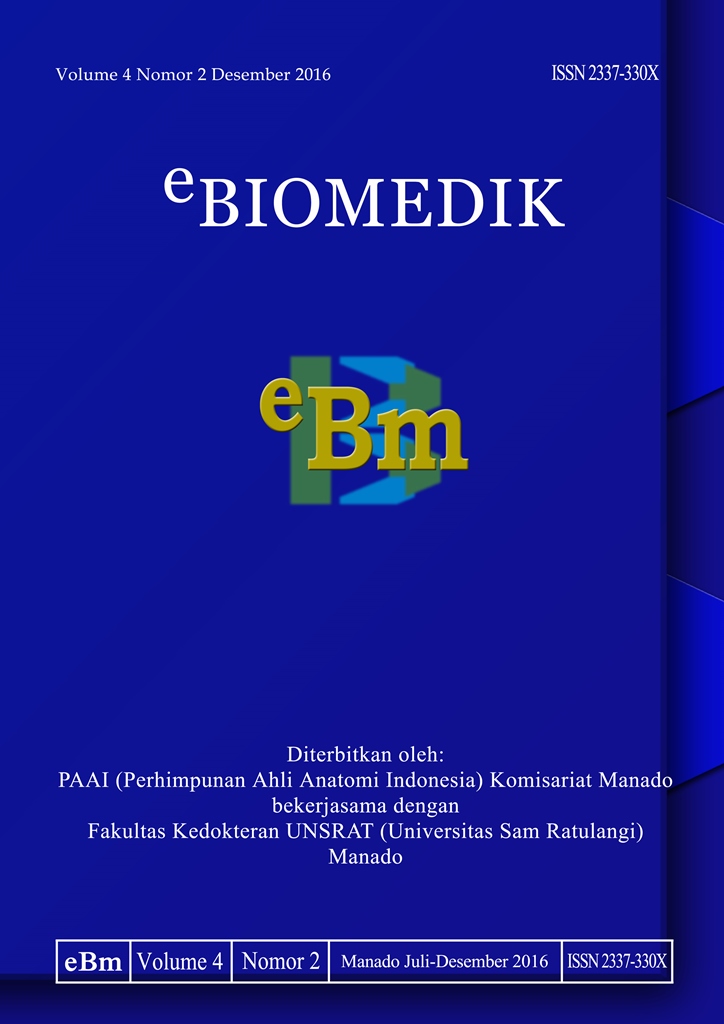Isolasi dan identifikasi bakteri aerob yang berpotensi menyebabkan infeksi nosokomial di Irina D RSUP Prof. Dr. R. D. Kandou Manado
DOI:
https://doi.org/10.35790/ebm.v4i2.14658Abstract
Abstract: Infection is still one of the major causes of mortality and morbidity in the hospital. In Indonesia, infection is a major cause of maternal death and newborn, and also led to an extension of hospitalization for patients. Nosocomial infections are infections suffered by patients that were admitted to the hospital after ± 72 hours of admission originated from microbiological and environmental factors. Germs that cause most frequent nosocomial infections are Proteus sp, Escherichia coli, Staphylococcus aureus and pseudomonas. This study was aimed to isolate and identify the most common aerobic bacteria that could potentially be the causes of nosocomial infections at IRINA D Prof. Dr. R. D. Kandou Hospital Manado. There were 27 samples consisting of 8 air samples and 19 samples of swab the surface of walls, floors and furniture. Identification of bacteria was performed by using cultures, Gram staining, and biochemical tests. Of the 27 samples 7 types of bacteria are found. Serratia liquefaciens is the largest with 12 samples (44.4%) Basillus subtilis with 7 samples (25.9%), Enterobacter aerogenes in 3 samples (11.1%), Serratia marcescens in 2 samples (7.4%), while Enterobacter agglomerans, staphylococcus sp, coccus Gram negative each in one sample (each of 3.7%). Gram-negative bacteria were the most common bacteria found at IRINA D RSUP Prof. Dr. R. D. Kandou Manado. Serratia liquefaciens was the main bacteria considered to be potentially the cause nosocomial infection.
Keywords: identification of bacteria, nosocomial infections, inpatient installation
Â
Abstrak: Infeksi masih merupakan salah satu penyebab utama kematian dan kesakitan di rumah sakit. Di Indonesia sendiri infeksi merupakan salah satu penyebab utama kematian ibu dan bayi baru lahir dan juga menyebabkan perpanjangan masa rawat inap bagi penderita. Infeksi nosokomial merupakan infeksi yang tidak diderita pasien saat masuk ke rumah sakit melainkan setelah ±72 jam berada di tempat tersebut yang berasal dari faktor mikrobiologis dan faktor lingkungan. Kuman penyebab infeksi nosokomial yang paling sering ialah Proteus sp, Escherichia coli, Staphylococcus aureus dan Pseudomonas. Penelitian ini bertujuan untuk mengisolasi dan mengidentifikasi bakteri aerob terbanyak yang berpotensi menjadi penyebab infeksi nosokomial di irina D RSUP Prof. Dr. R. D. Kandou Manado. Sampel diambil sebanyak 27 sampel yang terdiri dari 8 sampel udara dan 19 sampel dari swab permukaan dinding, lantai dan perabotan. Untuk identifikasi bakteri dilakukan kultur pada media agar selanjutnya dilakukan pewarnaan Gram dan uji biokimia. Dari 27 sampel ditemukan 7 jenis bakteri. Serratia liquefaciens merupakan bakteri terbanyak dengan 12 sampel (44,4%) Basillus subtilis dengan 7 sampel (25,9%), Enterobacter aerogenes dengan 3 sampel (11,1%), Serratia marcescens dengan 2 sampel (7,4%), sedangkan Enterobacter agglomerans, Staphylococcus sp, coccus Gram (-) masing-masing didapatkan 1 sampel dengan presentase masing-masing 3,7%. Bakteri Gram negatif merupakan bakteri yang paling banyak ditemukan pada instalasi rawat inap D RSUP Prof. Dr. R. D. Kandou Manado. Serratia liquefaciens merupakan bakteri yang berpotensi menjadi penyebab infeksi nosokomial terbanyak yang ditemukan.
Kata kunci: identifikasi bakteri, infeksi nosokomial, instalasi rawat inap





